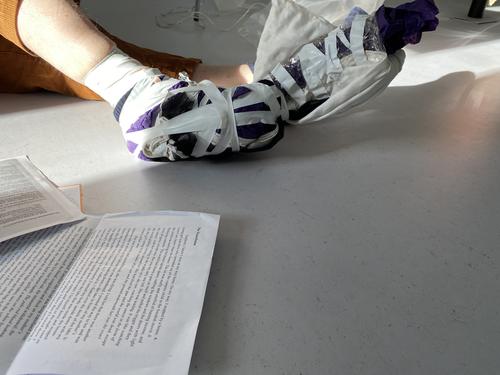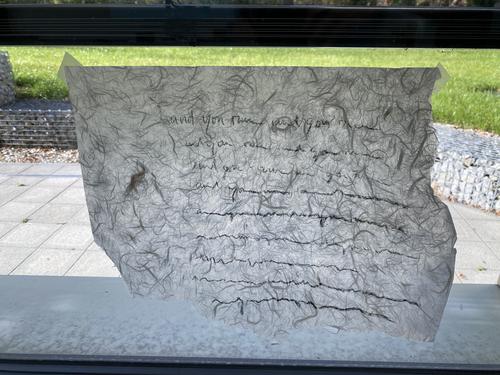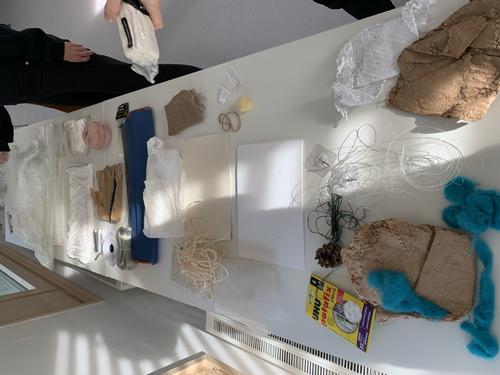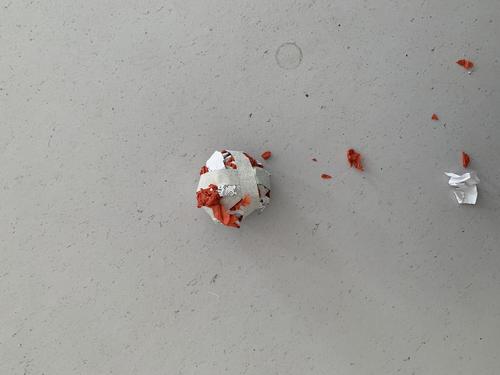Juicy, Wiry, Wrinkled, Kinked: On Touching Language
Experimental workshop, Nov 08, 2022
Juicy, Wiry, Wrinkled, Kinked, untitled image
Image Credit: Anouk Luhn and Sophie Seita
Juicy, Wiry, Wrinkled, Kinked, untitled image
Image Credit: Anouk Luhn and Sophie Seita
Juicy, Wiry, Wrinkled, Kinked, untitled image
Image Credit: Anouk Luhn and Sophie Seita
Juicy, Wiry, Wrinkled, Kinked, untitled image
Image Credit: Anouk Luhn and Sophie Seita
In this practice-based workshop, EXC Dorothea Schlegel Artist-in-Residence Sophie Seita invited participants to experiment with various techniques of writing and making, swimming in the mucky waters between languages or following the messy movement from one medium or material to another through layers of translation, adaptation, and citation. Leaning on or holding up theoretical work in queer studies, disability studies, and performance studies, the workshop traced the physicality of writing, its textures and gestures, its material and performative cracks and ridges. How do we translate our body into a space or object? What kind of real or imagined body can we conjure or work with? How can we give shape to metaphors of translation or metaphors within a specific translation? How do we create a physical or tactile translation through manipulating materials or interacting with our environment? What shapes, movements, actions, and affects does a particular material invite? How can we transpose an abstract idea or a vivid verbal image into a concrete movement or gesture?
The workshop proposed translation as a form of correspondence, and this correspondence can be more or less explicit and intimate. Or serious, or gossipy, or tender, or confusing, or defensive. Maybe it claws something back. Maybe it forgets its addressee and purpose and plays with words like clay, creating decals or transfers on a variable scale of proximity. Which we could call research. Or just making. How do we make things with other voices of the past or present and engage another text as if we were having a conversation with it, as if we had it (the text) over for dinner? Or maybe we’ll keep it at a safe distance, maybe we’ll treat this as an occasion for a complaint. These imaginary correspondences can take any form: poetic, narrative, dramatic, and might also lead to performance. The workshop will bring many voices into the room and think of ways we can speak to, with, or against them, caringly or recalcitrantly, or when we might not want to speak at all.
Participants were invited to play with materials, such as clay, string, paper, tape, felt fabric, plastic bags, salt, wire, etc., as well as with movement and gesture to create dialogues between texts and objects. The workshop was rooted in a spirit of play, curiosity, and experiment.
‘I think that everything is connected by translation and by a larger feeling of translation as movement and difference and reiteration and new avenues towards thinking about articulation.’ (Sawako Nakayasu)
‘We touch things to assure ourselves of reality. We touch the objects of our love. We touch the things we form.’ (Anni Albers)
‘to touch is always already to reach out, to fondle, to heft, to tap, or to enfold, and always also to understand other people or natural forces as having effectually done so before oneself, if only in the making of the textured object’ (Eve Sedgwick)
‘the haptic disrupts the prominence of vision as a metaphor for distant knowing as well the distance of critique, but it also calls for ethical questioning. What is caring touch in this context?’ (María Puig de la Bellacasa)



